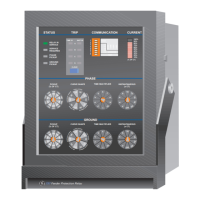GE Power Management
735/737 Feeder Protection Relay 4-1
4 MODBUS COMMUNICATIONS 4.1 OVERVIEW
4
4 MODBUS COMMUNICATIONS 4.1 OVERVIEW 4.1.1 DESCRIPTION
Communication with an external computer/PLC/SCADA system is useful for continuous status monitoring and for testing.
Two wire RS485 or four wire RS422 communication interfaces are available; RS485 being the preferred type, with RS422
available as an option.
The 735/737 implements a subset of the AEG Modicon Modbus serial communication standard. Modbus protocol is hard-
ware independent. The 735/737 supports RS485 and RS422 hardware configurations. Modbus is a single master / multiple
slave type of protocol suitable for a multi-drop configuration as provided by RS485 hardware. Using RS485, up to 32 slaves
can be daisy-chained together on a single communication channel. Due to address limitations only 31 735/737s can be put
on a single channel. However, another model of relay could be added, increasing the number to 32.
735/737 relays are always Modbus slaves. They can not be programmed as Modbus masters. Computers, PLCs or
SCADA systems are commonly programmed as masters. Modbus protocol exists in two versions: Remote Terminal Unit
(RTU, binary) and ASCII. Only the RTU version is supported by the 735/737. Both monitoring and control are possible
using read and write register commands. Commands are supported to provide additional functions.
4.1.2 ELECTRICAL INTERFACE
The 735/737 Modbus implementation employs two-wire RS485 hardware (4 wire RS422 is also available). Data flow is bidi-
rectional, referred to as half duplex. That is, data is never transmitted and received at the same time. For RS485 electrical
interface, receive and transmit data alternate over the same 2 wires.
RS485 lines should be connected in a daisy chain configuration with terminating resistors installed at each end of the link
(that is, at the master end and at the slave farthest from the master). The value of the terminating resistors should be
approximately equal to the characteristic impedance of the line. A recommended wire type is Belden #9841, 24 AWG
stranded, shielded twisted pair. This wire has a characteristic impedance of 120 Ω, thus requiring 120 Ω terminating resis-
tors. It is also recommended that a 1 nF / 50 V bidirectional capacitor be put in series with the terminating resistors thus
ensuring that the I/O terminals are biased correctly. Shielded wire should always be used to minimize noise. Polarity is
important in RS485 communications. The '+' terminals of every device must be connected together. See Section 2.2.4:
COMMUNICATIONS on page 2–8 for further wiring details.
4.1.3 DATA FRAME FORMAT AND RATE
One data frame of an asynchronous transmission to or from a 735/737 consists of 1 start bit, 8 data bits, and 1 stop bit to
produce a 10 bit data frame. This is important for transmission through modems at high bit rates (11 bit data frames are not
supported by some modems at bit rates of greater than 300 bps). Although Modbus protocol can be implemented at any
standard communication speed, the 735/737 supports operation at 1200, 2400, 9600 and 19200 baud by front panel switch
selection.

